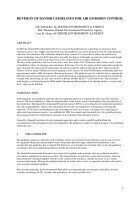Air monitoring
REVISION OF DANISH GUIDELINES FOR AIR EMISSION CONTROL
Oct 06 2014
Author: Ole Schleicher, Erik Thomsen and Lars K. Gram on behalf of CEM
ABSTRACT
In 2001 the Danish EPA will publish the first revision of the guidelines for controlling air emissions from stationary sources. In a simple and structured way, the guidelines sets up all necessary terms for controlling the emission of air pollution. The authorities should always evaluate if it is possible to reduce the pollution by cleaner technology based on BAT principles. Secondly the degree of demands on emission control, stack height and control program can be fixed, based on a series of limits for every single compound.
The keys in the guideline is the use of mass flow, mass flow limits, ELV (Emission Limit Values) and C-values (Contribution values for emission concentrations). If the mass flow for the single emitted compound exceeds the mass flow limit for that group of compounds, the emission shall be reduced beyond the ELV (Emission Limit Values). From a simple scheme the control program can be fixed to be either Performance monitoring, Spot-test measurements and/or AMS (Automatic Measuring Systems). The guideline specify in details how to perform the different emission monitoring and control systems, defining the regulating parameter, the monitoring period, the average time, and setting up clear rules on how to decide whether the ELV is fulfilled or not. The necessary stack height is calculated using the OML model (Operational Meteorological Air Quality model), to assure that the C-value can be fulfilled.
INTRODUCTION
In Denmark the local authority performs the environmental approval to regulate the emission from stationary sources. The local authority is either the municipalities or the county council, depending of the type and size of the production. The Danish Environmental Protection Agency (EPA) is converting the environmental legislation into rules and guidelines, which is the operational tool for the local authorities in preparing environmental approvals. To facilitate and homogenize the environmental work, a new type of guidance for controlling air emissions from stationary sources was published in 1990. In a simple and structured way, this guideline sets up all necessary terms for controlling the emission of air pollution from stationary sources.
Caused by changed legislation for environmental approvals, and a wish to simplify and facilitate the environmental work performed by the local authorities, the guideline is under revision. It expects to be published within this year.
Digital Edition
IET 35.2 March
April 2025
Air Monitoring - Probe Sampling in Hazardous Areas Under Extreme Conditions - New, Game-Changing Sensor for Methane Emissions - Blue Sky Thinking: a 50-year Retrospective on Technological Prog...
View all digital editions
Events
Apr 08 2025 Birmingham, UK
Apr 08 2025 Targi Kielce, Poland
Apr 08 2025 Baku, Azerbaijan
Apr 08 2025 Bahrain
Apr 10 2025 Beijing, China















